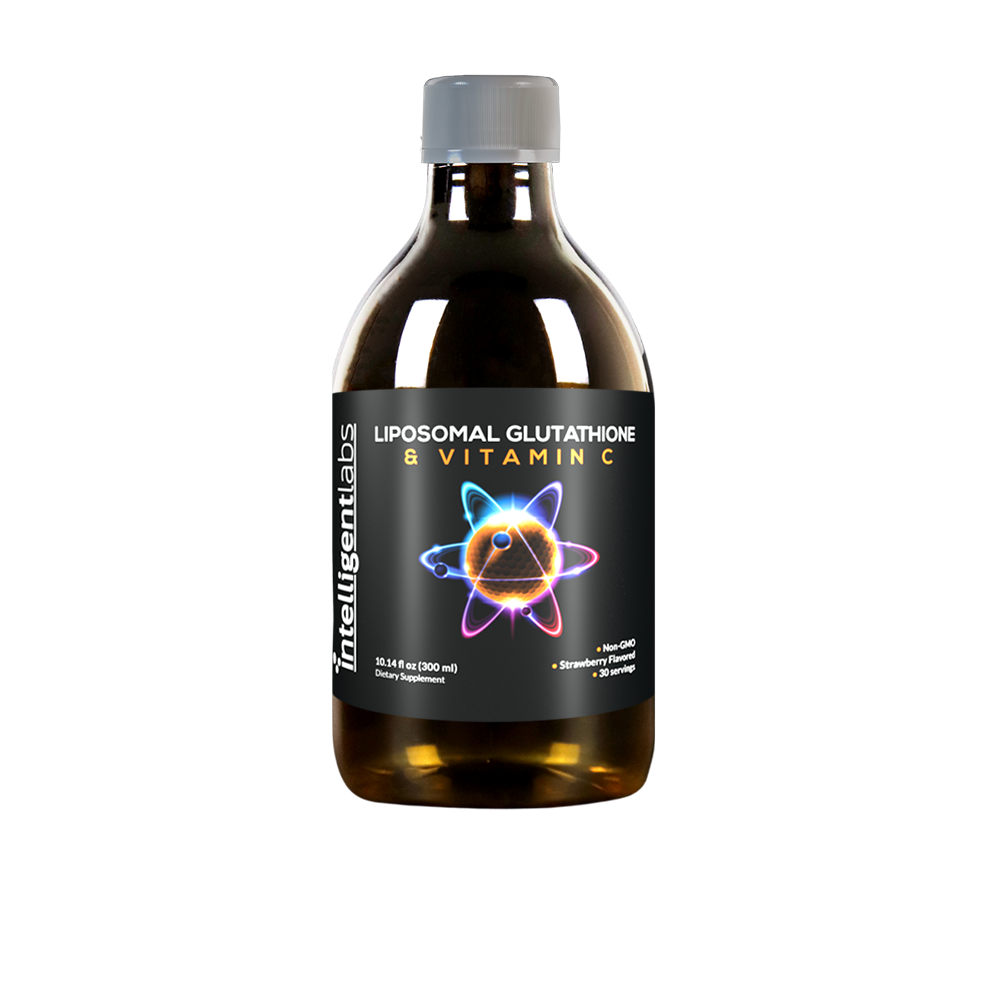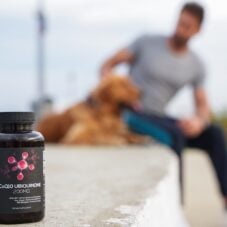Antioxidants
Liposomal Glutathione: An Ultimate Guide To The Body’s Master Antioxidant
Who hasn’t heard of glutathione by now? It’s everywhere – on TV, billboards, social media, and beauty blogs. Even celebrities rave about its amazing powers! But glutathione’s wonders go beyond skin deep. In this blog post, we’ll share plenty of reasons why you should consider taking our advanced liposomal glutathione supplement.
Table of Contents
But first, what exactly is glutathione?
But first, what exactly is glutathione?
Glutathione is more than just a beauty product. It’s the body’s main antioxidant, composed of three amino acids: glycine, cysteine, and glutamic acid.
Present in all tissues, especially in the liver, glutathione plays a key role in detoxification by fighting free radicals and drawing out toxins like mercury and heavy metals. 1 2
Interestingly, glutathione is found in the body in concentrations similar to life-sustaining nutrients like cholesterol, glucose, and potassium. 3
Glutathione exists in two forms:
- Reduced Glutathione (GSH): The active form that repairs oxidative damage (this is the form we use in our supplement).
- Oxidized Glutathione (GSSG): The inactive form that is regenerated back into GSH by the enzyme glutathione reductase.
Maintaining high glutathione levels is important for good health, but this becomes challenging as we age. The body’s natural production of glutathione declines over time.
Factors like stress, infection, illness, and exposure to toxic chemicals can further deplete glutathione levels. 4 This is where supplementation becomes beneficial.
What are free radicals and how do antioxidants like glutathione help?
Free radicals are unstable molecules missing electrons, like single dancers searching for partners. This ‘search’ can damage cells if not quickly stabilized.
Free radicals aren’t bad per se. They naturally occur from processes like metabolism and even support the immune system. The problem arises when there are too many free radicals and not enough antioxidants, leading to oxidative stress. 5
Oxidative stress makes free radicals ‘steal’ electrons from nearby molecules, damaging cells, altering lipids and proteins, and changing DNA. This damage can lead to serious health issues like heart disease, cancer, diabetes, and neurodegenerative diseases.
Antioxidants, like glutathione and vitamin C, neutralize free radicals by donating an electron without becoming unstable themselves. 6 This process helps protect your cells from damage.
Here’s how to maximize your antioxidant protection…
To ensure your cells get all the protection they need, we’ve combined two of the most powerful antioxidants into one supplement. Meet our Liposomal Glutathione & Vitamin C!
What sets our product apart from other glutathione supplements is our use of advanced liposomal technology, which encapsulates glutathione in microscopic liposomes. As a result, absorption and bioavailability are significantly enhanced. This means your body can fully benefit from both nutrients, unlike non-liposomal products where much of the active ingredient is lost during digestion.
Each 10 ml (2 tsp) serving contains 500 mg of Liposomal Glutathione and 1,000 mg of Vitamin C. This combo provides a potent combination for optimal health benefits. Our supplement is available as a strawberry-flavored liquid. This minimizes glutathione’s natural sulfur taste, making it not only effective but also pleasant to take. By adding our Liposomal Glutathione & Vitamin C to your daily routine, you can effectively combat oxidative stress and support your overall health.

What are the health benefits of taking glutathione?
Here are some of the benefits you will reap by supplementing with this powerful antioxidant:
Benefit #1: Fight oxidative stress
As mentioned in the previous section, oxidative stress results from an imbalance of free radicals and antioxidants, which can damage cells and DNA, leading to more serious health issues. Supplementing with glutathione provides a healthy dose of antioxidants to reduce oxidative damage and promote healing. 3
Benefit #2: Reduce inflammation
While inflammation is a natural immune response, chronic inflammation is harmful. Oxidative stress can lead to chronic inflammation and diseases. Glutathione fights oxidative stress, thereby reducing inflammation. It may even help treat certain lung diseases resulting from inflammation. 7
Benefit #3: Regenerate other antioxidants
Glutathione helps regenerate other antioxidants like vitamins C and E, enhancing their ability to fight oxidative stress. This synergy gives your body a better chance of staying healthy. 3
Benefit #4: Protection from toxic materials and pollutants
Glutathione is also a master detoxifier, especially abundant in the liver. It binds to metals, toxins, and pollutants, transforming them into water-soluble compounds for excretion. 8
Glutathione has been used to treat chronic liver diseases (such as nonalcoholic fatty liver disease) and acute poisoning. This is usually administered via IV injection for maximum absorption. 9
Benefit #5: Get more energy
Glutathione protects the mitochondria, the powerhouses of cells, from oxidative damage by reactive oxygen species (ROS). This protection helps maintain energy production, giving you more energy throughout the day. 10
Benefit #6: Improve mental and brain health
Low glutathione levels are linked to chronic stress, anxiety, depression, schizophrenia, bipolar disorder, and OCD. Supplementing with glutathione can restore its levels and improve these conditions. 11 12
Benefit #7: Improve your immunity
Glutathione improves your health at a cellular level, so it’s not surprising to know that supplementing with it may support your health in so many ways. In addition to the other glutathione benefits already listed in this section, this antioxidant may also help boost your overall immunity. 13
Benefit #8: Younger-looking skin
Glutathione is marketed as a beauty product in many countries, especially in Asia. Studies have shown that you can glow naturally with liposomal glutathione’s skin benefits! A daily dose of 250mg to 500mg may reduce wrinkles, improve skin elasticity, and lighten skin pigmentation. 14 15
What’s the best form of glutathione – oral, liposomal, or intravenous?
Glutathione comes in many forms: pills, tablets, capsules, soap, lotion, and even injections. Let’s focus on the three most popular methods: oral, liposomal, and intravenous (IV). We’ll compare them based on bioavailability, price, and convenience.
Liposomal Glutathione

Liposomal glutathione is a step up from traditional oral supplements. It involves encasing glutathione molecules in liposomes, tiny protective bubbles made from phosphatidylcholine, a major component of cell membranes. 16 These liposomes shield the glutathione from digestive enzymes and bile salts, ensuring it reaches the bloodstream intact. 17
Adding vitamin C to our liposomal glutathione enhances its effectiveness. Vitamin C regenerates oxidized glutathione back to its active form, ensuring a steady supply of this critical antioxidant. Additionally, vitamin C itself is a potent antioxidant, providing extra protection against oxidative stress.
Liposomal glutathione offers significantly better absorption and bioavailability compared to regular oral forms. It comes in both softgel and liquid forms. Softgels are convenient for on-the-go use, while the liquid form allows for flexible dosing, though it requires measuring with a dropper or teaspoon.
- Convenience: 4/5 (softgel is convenient; liquid needs measuring)
- Bioavailability: 4/5 (enhanced absorption due to liposomes)
- Price: 4/5 (more expensive than oral but worth it for better absorption)
Oral Glutathione

Oral glutathione is taken in pill, capsule, or tablet form. It’s affordable, with a 2-month supply costing around $20-$30. However, its bioavailability is low because stomach enzymes degrade much of it before it reaches the bloodstream. 18 This means not all of the glutathione you ingest is effectively absorbed, making it less efficient despite its lower cost.
- Bioavailability: 1/5 (poor absorption rates)
- Price: 4/5 (cheapest option)
- Convenience: 5/5 (very easy to take)
Intravenous Glutathione

IV glutathione is administered directly into the bloodstream, bypassing the digestive system entirely, which ensures maximum absorption.19 However, this method is the most expensive and least convenient, often requiring professional administration and multiple sessions per week, each taking 30 minutes to an hour. Despite its high bioavailability, the body’s ability to utilize the entire dose can vary, and excessive use can lead to side effects. 20
- Bioavailability: 5/5 (highest absorption rates)
- Price: 1/5 (very costly)
- Convenience: 1/5 (requires professional administration and is time-consuming)
So, what’s the best form of glutathione in terms of bioavailability, price, and convenience?
Money doesn’t grow on trees, so depending on your financial capacity and your antioxidant needs, we suggest the following course of action:
Liposomal Glutathione offers the best balance of bioavailability, price, and convenience. Its advanced delivery system (via liposomes) ensures better absorption than traditional oral supplements, making it a more efficient choice. Moreover, the added vitamin C in our product boosts the effectiveness of glutathione and provides additional antioxidant protection.
If you can afford several IV glutathione sessions without batting an eyelash, then go for this option. It’s a surefire way of getting the most amount of glutathione directly into your body. If you’re on a strictly limited budget, oral glutathione is your best bet for getting some of this antioxidant in you.
What to look for in the best liposomal glutathione supplement?
A quick search online will yield hundreds of liposomal glutathione products. To help narrow down your search, here are a few pointers on what you should be looking for in a liposomal glutathione supplement.
Added Vitamin C
Glutathione is already a powerful antioxidant on its own. Adding Vitamin C ensures a potent combination for optimal benefits. Our formula further boosts the effectiveness of glutathione with extra antioxidant protection!
Liquid vs. softgel form
Both forms offer better absorption rates than traditional oral glutathione. Softgels are more convenient but don’t allow for easy dosage adjustments. On the other hand, liquid liposomal glutathione offers maximum control, allowing you to start with a smaller dose and adjust as needed.
Dosage
Our product offers 500 mg of glutathione and 1000 mg of vitamin C per serving. Studies have shown that even taking 1000mg/day of glutathione does not lead to adverse outcomes or interfere with the body’s natural production.21 As for vitamin C dosage, it’s a water-soluble vitamin that doesn’t get stored in the body, so any excess is simply excreted.
We recommend you speak with your doctor if you intend to take more than our suggested serving size.
Taste
Glutathione has a sulfur component, giving it a distinct taste. We’ve added a natural, sugar-free strawberry flavor to make our supplement more palatable.
Price
Liposomal glutathione offers excellent value compared to oral and IV glutathione. Prices can vary, but our Intelligent Labs Liposomal Glutathione & Vitamin C is competitively priced for thirty servings (a 1-month supply).

How long should you supplement? Any side effects?
You can supplement for as long as needed. Glutathione and vitamin C are generally safe with no serious adverse reactions in clinical trials. Long-term use at the recommended dose is fine, but high doses over prolonged periods may cause issues like hypopigmented patches, lightened hair color, and increased melanoma risk. Always consult with your doctor for long-term high-dose use.
Check out our list of what to avoid when taking glutathione.
Can pregnant women take this supplement?
Oxidative stress also happens during pregnancy, but it’s necessary for placental development and normal cell function. There’s an expected increase in oxidative stress, but it should be stable in a healthy pregnancy. Otherwise, uncontrolled oxidative stress can lead to pregnancy complications like preeclampsia. 22
So, while glutathione and antioxidants, in general, can have a positive health impact, our official advice is to consult with your physician before taking any dietary supplements.
What about breastfeeding moms? Is liposomal glutathione safe for them?
Glutathione in a nursing mother’s milk is beneficial for newborns, especially in the first month when infants can’t produce glutathione on their own. After the first month, glutathione levels in milk decrease. 23
Breastfeeding provides essential nutrients and protection against infections. However, anything you consume, including supplements, can pass into your breast milk.
As with pregnant women, consult your physician before taking glutathione supplements while breastfeeding.
Final words
We hope you’ve enjoyed learning about glutathione and its incredible benefits. As you now know, glutathione is essential for your body’s health and well-being. Traditional oral glutathione doesn’t absorb well, and IV glutathione can be a hassle. That’s why our Liposomal Glutathione & Vitamin C is the best choice – it’s easy to take, highly absorbable, and won’t break the bank. Give it a try and feel the difference!
💬 Something on your mind? Share your thoughts in the comments. We love hearing from curious minds.
📩 And while you’re here, join our newsletter for more smart stuff (and secret perks)!
References:
- PubChem. “Glutathione.” Pubchem.ncbi.nlm.nih.gov, pubchem.ncbi.nlm.nih.gov/compound/glutathione. ↩︎
- Chen, Y, et al. “GLUTATHIONE DEFENSE MECHANISM in LIVER INJURY: INSIGHTS from ANIMAL MODELS.” Food and Chemical Toxicology : An International Journal Published for the British Industrial Biological Research Association, vol. 60, 1 Oct. 2013, pp. 38–44, https://doi.org/10.1016/j.fct.2013.07.008. ↩︎
- Pizzorno, Joseph. “Glutathione!” Integrative Medicine (Encinitas, Calif.), vol. 13, no. 1, 1 Feb. 2014, pp. 8–12, pubmed.ncbi.nlm.nih.gov/26770075/. ↩︎
- Ballatori, Nazzareno, et al. “Glutathione Dysregulation and the Etiology and Progression of Human Diseases.” Biological Chemistry, vol. 390, no. 3, 1 Mar. 2009, pp. 191–214, https://doi.org/10.1515/BC.2009.033. ↩︎
- Pham-Huy, Lien Ai, et al. “Free Radicals, Antioxidants in Disease and Health.” International Journal of Biomedical Science : IJBS, vol. 4, no. 2, June 2008, pp. 89–96. ↩︎
- Lobo, V, et al. “Free Radicals, Antioxidants and Functional Foods: Impact on Human Health.” Pharmacognosy Reviews, vol. 4, no. 8, July 2010, pp. 118–126, https://doi.org/10.4103/0973-7847.70902. ↩︎
- Ghezzi, P. “Role of Glutathione in Immunity and Inflammation in the Lung.” International Journal of General Medicine, Jan. 2011, p. 105, https://doi.org/10.2147/ijgm.s15618. ↩︎
- Jiang, Xingya, et al. “Noninvasive Monitoring of Hepatic Glutathione Depletion through Fluorescence Imaging and Blood Testing.” Science Advances, vol. 7, no. 8, Feb. 2021, p. eabd9847, https://doi.org/10.1126/sciadv.abd9847. ↩︎
- Honda, Yasushi, et al. “Efficacy of Glutathione for the Treatment of Nonalcoholic Fatty Liver Disease: An Open-Label, Single-Arm, Multicenter, Pilot Study.” BMC Gastroenterology, vol. 17, 8 Aug. 2017, https://doi.org/10.1186/s12876-017-0652-3. ↩︎
- Bolisetty, Subhashini, and Edgar Jaimes. “Mitochondria and Reactive Oxygen Species: Physiology and Pathophysiology.” International Journal of Molecular Sciences, vol. 14, no. 3, 19 Mar. 2013, pp. 6306–6344, https://doi.org/10.3390/ijms14036306. ↩︎
- Krolow, R., et al. “Oxidative Imbalance and Anxiety Disorders.” Current Neuropharmacology, vol. 12, no. 2, 31 Mar. 2014, pp. 193–204, https://doi.org/10.2174/1570159×11666131120223530. ↩︎
- Berk, Michael, et al. “N-Acetyl Cysteine as a Glutathione Precursor for Schizophrenia—a Double-Blind, Randomized, Placebo-Controlled Trial.” Biological Psychiatry, vol. 64, no. 5, Sept. 2008, pp. 361–368, https://doi.org/10.1016/j.biopsych.2008.03.004. ↩︎
- Ghezzi, P. “Role of Glutathione in Immunity and Inflammation in the Lung.” International Journal of General Medicine, Jan. 2011, p. 105, https://doi.org/10.2147/ijgm.s15618. ↩︎
- Weschawalit, Sinee, et al. “Glutathione and Its Antiaging and Antimelanogenic Effects.” Clinical, Cosmetic and Investigational Dermatology, vol. Volume 10, Apr. 2017, pp. 147–153, https://doi.org/10.2147/ccid.s128339. ↩︎
- Handog, Evangeline B., et al. “An Open-Label, Single-Arm Trial of the Safety and Efficacy of a Novel Preparation of Glutathione as a Skin-Lightening Agent in Filipino Women.” International Journal of Dermatology, vol. 55, no. 2, 3 July 2015, pp. 153–157, https://doi.org/10.1111/ijd.12999. ↩︎
- Sinha, R., et al. “Oral Supplementation with Liposomal Glutathione Elevates Body Stores of Glutathione and Markers of Immune Function.” European Journal of Clinical Nutrition, vol. 72, no. 1, 1 Jan. 2018, pp. 105–111, https://doi.org/10.1038/ejcn.2017.132. ↩︎
- Akbarzadeh, Abolfazl, et al. “Liposome: Classification, Preparation, and Applications.” Nanoscale Research Letters, vol. 8, no. 1, 22 Feb. 2013, https://doi.org/10.1186/1556-276x-8-102. ↩︎
- Allen, Jason, and Ryan D. Bradley. “Effects of Oral Glutathione Supplementation on Systemic Oxidative Stress Biomarkers in Human Volunteers.” The Journal of Alternative and Complementary Medicine, vol. 17, no. 9, Sept. 2011, pp. 827–833, https://doi.org/10.1089/acm.2010.0716. ↩︎
- Sonthalia, Sidharth, et al. “Glutathione as a Skin Whitening Agent: Facts, Myths, Evidence and Controversies.” Indian Journal of Dermatology, Venereology, and Leprology, vol. 82, no. 3, 2016, p. 262, https://doi.org/10.4103/0378-6323.179088. ↩︎
- Sonthalia, Sidharth, et al. “Glutathione for Skin Lightening: A Regnant Myth or Evidence-Based Verity?” Dermatology Practical & Conceptual, vol. 8, no. 1, 31 Jan. 2018, pp. 15–21, https://doi.org/10.5826/dpc.0801a04. ↩︎
- Richie, John P., et al. “Randomized Controlled Trial of Oral Glutathione Supplementation on Body Stores of Glutathione.” European Journal of Nutrition, vol. 54, no. 2, 5 May 2014, pp. 251–263, https://doi.org/10.1007/s00394-014-0706-z. ↩︎
- Mannaerts, Dominique, et al. “Oxidative Stress in Healthy Pregnancy and Preeclampsia Is Linked to Chronic Inflammation, Iron Status and Vascular Function.” PLOS ONE, vol. 13, no. 9, 11 Sept. 2018, pp. e0202919–e0202919, https://doi.org/10.1371/journal.pone.0202919. ↩︎
- Ankrah, N-A. “Human Breastmilk Storage and the Glutathione Content.” Journal of Tropical Pediatrics, vol. 46, no. 2, 1 Apr. 2000, pp. 111–113, https://doi.org/10.1093/tropej/46.2.111. ↩︎




